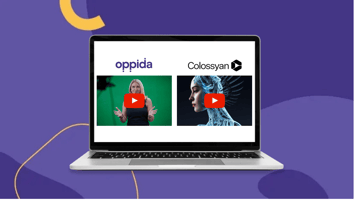The Colossyan Creator team in the UK recently reached out to Oppida to showcase their DIY AI video...
What’s a Style Sheet in video production? (The secret to faster edits, flawless branding, and zero delays)
“Video Style Sheet?? I don’t remember being sent a sheet!”
The video Style Sheet, sometimes called the video style guide, can seem like a mysterious element within the video production domain of course development projects. However, there’s a reason why it comprises its own step in the video production process… It deserves careful attention!
For reference, here are the steps to video production:
- Scripting
- Filming
- Post-production planning
- Apply the Style Sheet
- Editing
- Revisions
- Delivery
It is very important that everyone in the project understands what a Style Sheet is, otherwise it can cause confusion, and subsequently, project delays.
What is the purpose of a video Style Sheet?
A video Style Sheet serves a few distinct and important purposes:
- Consistency: Ensures uniform look and feel across all videos.
- Efficiency: Speeds up editing by providing predefined visual standards.
- Scalability: Simplifies collaboration and onboarding of new editors.
- Brand integrity: Maintains the client’s visual identity throughout the course.
- Future-proofing: Allows for easy updates and continuity in future projects.
What is needed to create a video Style Sheet?
In order to create the Style Sheet from scratch, a video editor needs the following assets:
- Brand style guide: The document outlining visual and tonal standards (fonts, colours, imagery) to ensure brand consistency across all content, usually shared as a PDF.
- Brand logo: This should be provided in a vector format such as .svg.
The branding assets are followed closely when creating a Style Sheet, however, a few alterations are sometimes made to benefit the learners. More on that below!
What is a video Style Sheet?
This is where confusion can set in. Contrary to what many might expect, a Style Sheet isn’t typically a ‘sheet’ in the traditional sense. Like many digital assets, a Style Sheet has both a front end and a back end—the front end is what appears in the video, while the back end contains the settings and controls accessible to the video editor. This means that a Style Sheet is shared across project teams in various formats. Read on to understand what YOU should expect the Style Sheet to look like for your particular role.
Front-end
To the subject matter experts, stakeholders, and program leaders - this applies to you! If your program or course contains videos, your chosen education provider - hopefully Oppida ;) - will ask you to review and approve the video Style Sheet. This is often at a critical moment in any project, as the work is well and truly in full swing at this point. The course storyboards are designed, the scripts are written, and some footage may already be filmed—so there's no turning back!
To stay on track with project timelines, having a good understanding and eye for Style Sheet elements will help the project progress faster and more smoothly.
Depending on the project timeline, the Style Sheet can either be presented as a templated video presentation, or as the actual first video in the project. There are pros and cons to each method.
Templated video presentation
|
PROS |
CONS |
|
The content is clear and focused, containing only Style Sheet elements, minimising confusion about which elements need feedback. |
Presenting the Style Sheet this way requires additional effort outside the core course work. It essentially becomes a standalone video focused solely on showcasing the Style Sheet elements clearly for the client. |
Example:
First project video
|
PROS |
CONS |
|
This approach is ideal for projects on a tight schedule, as it effectively combines two tasks: developing the Style Sheet and producing the first video. It’s most effective when the video selected includes a broad range of post-production elements, showcasing the Style Sheet's versatility and ensuring a thorough presentation. |
This approach can be riskier if the client isn’t familiar with Style Sheet elements. For instance, they might provide feedback on text spelling, B-roll, unique motion graphics, or the presenter’s appearance. While these are valid points for the video itself, they fall outside the scope of the Style Sheet. |
Contact Oppida to create a Style Sheet for your project
Back-end
Education provider teams - this section is for you! Style sheets are typically shared in .aep format, which stands for "After Effects Project." This format is widely used because Adobe Premiere Pro, integrated with After Effects, is the industry standard, offering versatility and control in editing. This .aep file contains project settings for the elements that remain constant across all videos in a given project. This includes everything mentioned in the front-end section, as well as project settings:
- Video renderer settings
- Colour settings
- Audio settings
- Time display style.
The video editor will either create a Style Sheet from scratch or use one provided by the client. It’s an invaluable asset for clients to use for projects of the present and future, as it allows them to uphold a specific look and feel even if they switch education providers or video editors.
What is NOT a Style Sheet?
It’s equally important for everyone on the project team to understand what a video Style Sheet includes and what it doesn’t. If your education provider submits the project’s first draft video for Style Sheet review, here’s a (by no means extensive) list of elements to hold back on and avoid commenting on:
- Text spelling and grammar
- B-roll selection
- One-off motion graphics
- Presenter’s appearance
- Script content
- Lighting or set design
- Video length or pacing
- Dialogue sound quality
- On-screen text formatting specifics
- Shot-specific colour or angle corrections
These points of feedback should be noted once the Style Sheet is approved.
And there you have it—a complete guide to understanding and reviewing video Style Sheets for education design projects. The Style Sheet stage can either streamline the process or present challenges. By focusing on the right elements during this review, projects can move forward more quickly, as education providers anticipate potential bottlenecks and plan accordingly in their Gantt charts. Best of all, once the video Style Sheet is approved, it’s final: a polished, plug-and-play tool for the rest of the project.


